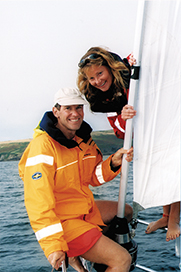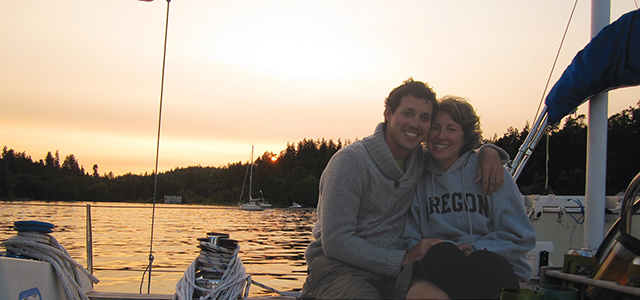BWS authors share their favorite safety and communication gear (published September 2012)
Without question, our most valuable and useful piece of electronics is an ICOM 802 SSB with Pactor modem. We use it for email, gathering WeatherFax and GRIB file data, chatting with friends and listening to weather forecasters like Chris Parker. We have gone without depth sounders, radar or GPS in the past and gotten along quite well, but if our SSB was not aboard we would feel cut off from the world. AIS has also made our lives much easier on night watches; just seeing a set of lights and knowing the closest point of approach makes for a much more relaxing watch!
-Todd Duff
In the area of communications, we’ve been surprised at how useful our Kindle has been. One of the cheaper versions, at $139 now on Amazon.com, comes with a keyboard, free 3G worldwide, and an experimental web browser that, while slow and clunky, allows you to easily access email, weather reports and basic news sites. It’s slow, won’t play any plug-ins and doesn’t work on some sites, but anywhere there’s a 3G phone system it not only allows you to download and read books, but also access important safety information quickly. We’ve used it for weather reports when there’s no local Wi-Fi, looking up sailing directions and cautions when diverting to an unplanned harbor, and updating our blog via email.
-Heather Hamilton
The most essential pieces of gear on Yahtzee are the ones I hope to never use—our liferaft, EPIRB, fire extinguishers and flares. People complain about their cost when fitting out a boat, but in an emergency they could be the difference between life and death, so the price of getting them serviced and repaired is something I don’t balk at.
-Andrew Cross
Since purchasing our Vesper Marine AIS Watchmate receiver, we have been in heavy shipping traffic where our AIS has made a huge difference in our stress levels. Pre-AIS, we would have spent hours watching and worrying, trying to determine which way a ship was headed—now we simply check the AIS and in an instant we know whether to alter course or not. We don’t even coastal cruise without our magic box anymore.
-Connie McBride
One of the most important pieces of safety equipment we cruise with is a simple cockpit jackline. Cheap and easy to install, the three-foot long line allows us to clip in before we leave the companionway or before switching over to the deck jacklines. It took only a day’s work to splice a rope and mount two U bolts (with suitable backing plates) in the cockpit. Now we remain safely clipped in during night watches or in foul weather. Many cruisers invest in far more complicated and expensive gear, yet overlook this critical first point of safety on board.
-Nadine Slavinski
I can narrow our most essential gear down to three items—a single-side band radio, a reliable self-steering system and a passive battery charging system. The benefit of an SSB over a sat phone is that cruisers can participate in “nets” that share weather and safety information to a number of yachts at once. Our Scanmar Monitor is truly a third crew member, silently steering the boat without using any power in all conditions. We’ve also had excellent customer service from Scanmar. Our 75-watt solar panels provide enough electricity for all of our navigation needs. We used less than 30 gallons of fuel sailing from Panama to Honolulu and only needed to run the engine once to charge the batteries. We have not plugged into shore power in two-and-a-half years.
-Marci Paravia
Radar remains the most valuable electronic navigation aid, and for sailors it pays to add the luxury of a heading sensor so you can use a stabilized display. A lower budget item would be an AIS receiver. Seeing nearby ship traffic right on your electronic charting system is a tremendous aid to safe navigation. The step up from that would be a transmitter, so they can see you as well by AIS.
-David Burch
Our secondary anchor is a Fortress. It has great holding power, is easily deployed and I can lift it. Our autopilot is essential when sailing double-handed—I have to be able to make that cup of tea! We use a Raymarine attached to a Jefa steering system.
-Jessica Johnson
The most essential “piece of equipment” is a thorough familiarity with all systems on board so when something goes wrong you can quickly reason out the situation and decide how to repair it. After that comes a well-thought-out tool kit and spares inventory. As far as safety equipment, after PFDs with harnesses and tethers comes our man overboard alarm system with wrist sensors that activate an alarm on the boat if the wearer ends up in the water. When the crew is a couple, this could be the difference between a quick MOB recovery or leaving a spouse hours away in a vast ocean.
-Peter Dubler

Two products I really appreciate and rely on are the Raymarine C-80 chartplotter/display and the Iridium 9555 sat phone. I installed the Raymarine C-80 about six years ago, and just three months ago installed a Raymarine 650 AIS transponder. We use the C-80 as a display for our 48-mile radar and as a chartplotter, and we’ve been generally impressed with the accuracy of the Navionics charts and appreciate the low power consumption. The Iridium 9555 sat phone is what we depend on for daily weather updates via GRIB files and for email communication.
-John Neal
One of my favorite “items” to have on board is Navigatrix, a complete operating system for your computer that includes electronic tools for navigation, communication, information and security. It is extremely robust and lightweight, and can be installed on the hard drive alongside your current OS or run from a 1.3 gigabyte USB stick. Navigatrix comes with OpenCPN Chartplotter, zyGrib grib file viewer, Airmail for HAM and Sailmail, GPS interfacing, MS Office compatible word processor and spreadsheet, Shotwell photo organizer, and many more tools. Best of all, it’s fully preconfigured and does what it needs to do “out of the box.” Download it for free at www.navigatrix.net.
-Markus Schweitzer
Our long-range boat has an array of electronics plus all the comforts we need without the excess and headaches of generators and things like air conditioners. If we had to strip away systems and really get down to basics, there are two things we would not care to sail without. The Vesper Marine AIS display, paired with a West Marine AIS transponder/receiver, draws nearly no electricity and alerts us to the location of ships, near and on the other side of the horizon. And the Monitor self-steering vane keeps our hands free of the steering wheel for days at a time and uses no electricity.
–Patrick and Rebecca Childress
Hands down, my most essential equipment is my VHF radio, particularly if you consider the fact that it also receives lifesaving weather information from NOAA. A very close second would be my chartplotter. There is no substitute for knowing exactly where you are vis-à-vis shallow water and obstructions, or where you might be in the mighty Atlantic! And at the end of the day, you need a totally trustworthy anchor on lots of chain. I sleep wonderfully at night because my Bruce anchor is two sizes too big for my boat (God forbid I should ever have to get it off the bottom without the electric windlass). When Big Bruce is on the job, we stay where we are put!
–Linda Amstutz















